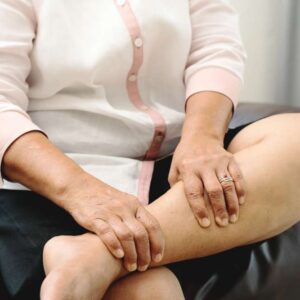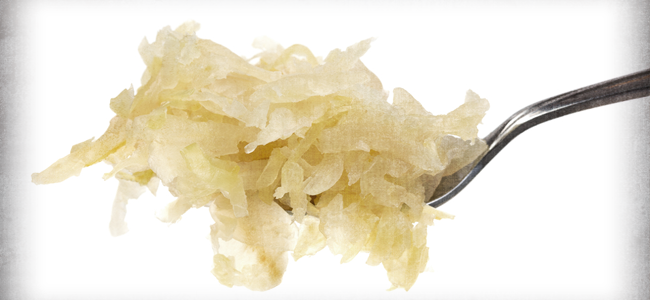
Gott im Himmel! That’s Good Sauerkraut!
“I’ve got something you really need to try.”
Five years ago, Andrew Weil, MD, invited me into the kitchen of his Tucson kitchen, spoke these fateful words, and gave me a conspiratorial wink.
I was at his home to discuss a writing project. But aside from being America’s best-known authority on natural health and healing, Weil was — and is — a brilliant and dedicated gastronome:
- Exhibit one: He has his own chain of hugely successful True Food Kitchen restaurants
- Exhibit two: His kitchen has a walk-in refrigerator.
So the implied question — should we keep grinding on the literary front or stuff our pie holes? — was a no-brainer.
“Bring it,” I said.
Retreating to his pantry, he emerged with a 14-inch-tall ceramic crock. Its top was a circular trench filled with water. The heavy lid’s rim sat in this trench, forming an airtight seal.
He removed the lid, pulled two C-shaped ceramic stones from the interior, and then spooned a generous portion of light-green cabbage for me and one for himself.
“When I was a kid growing up in Philadelphia, the German delis had sauerkraut just like this, actively fermenting in huge barrels,” he said, stabbing his portion with a fork.
Yeah, whatev, I thought. I’d had plenty of canned sauerkraut as a kid. Limp, vinegary, and salty as squid tears. However…
When I took a bite, I knew that I should have trusted the good doctor. Revelation! Teutonic redemption! Crunchy! Piquant! With just enough salt to make it sing!
Gott im Himmel, that’s good sauerkraut!
It was a life-changing moment. Shortly afterward, my wife, Laurie, and I bought this fermenting crock and began chucking all manner of shredded vegetation inside.
While we’ve tried Korean kimchi and various other fermented dishes, we keep returning to making plain sauerkraut.
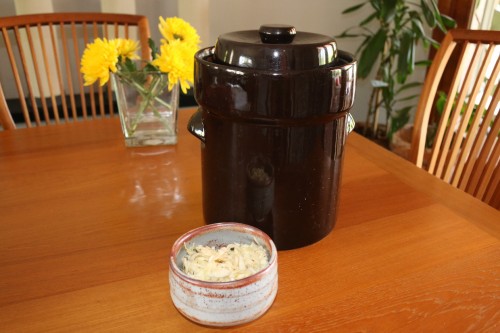
It’s delicious and nutritious — a rich source of B-complex, C, and K vitamins; calcium and magnesium; and dietary fiber.
But most importantly, raw sauerkraut is a rich source of live lactobacilli, the organisms that impart its characteristic sour flavor. Eating it supports the growth of healthy gut flora — which is, in turn, increasingly understood to be the foundation of robust physical and even mental health.
In fact, several studies link frequent raw sauerkraut consumption to lowered cancer risk.1
So… you can buy sauerkraut with live cultures, but at north of $7 a pound, it’s no bargain.
Fortunately, making it at home is simplicity itself.
Shred two heads of fresh cabbage either with a sharp knife or food processor. Mix in a large bowl with roughly 3 tablespoons of salt. Pack the salted shreds in the crock. Press hard with your fist.
Place the two half-circle-shaped ceramic weights (these come with fermenting crocks; a heavy plate will also work) on top of the cabbage.
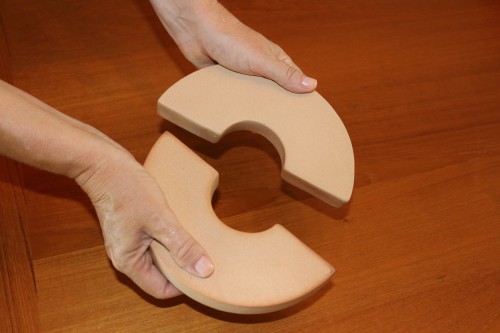
Fill the crock’s rim-trough with water and put on the lid. This forms a one-way seal. Carbon dioxide from the fermenting process can bubble out, but fresh air — which may foster mold growth — can’t get in.
If visible brine does not form naturally within 24 hours, add salted water — roughly 1 teaspoon of salt per cup — until the weights are barely covered.
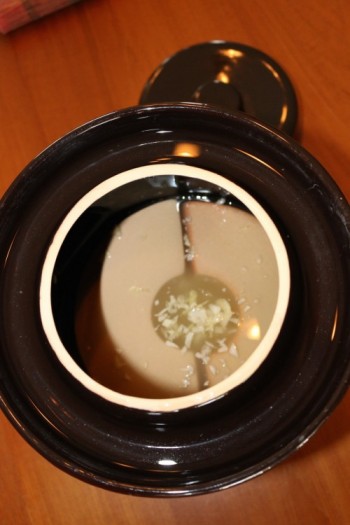
Now comes the hard part — patience!
Good sauerkraut takes time. At our typical kitchen temperature of about 74 degrees, it’s tasty at three weeks, but perfect at four and good for at least six.
Once it tastes right, it can go into fridge, covered, for several weeks more. And don’t forget to drink the juice, which offers many of the same therapeutic effects as the fermented cabbage itself.
I hope you enjoy your sauerkraut journey as much as Laurie and I have. To this day, we offer enduring thanks to our friend Andrew Weil for showing us the way.
Regards,

Brad Lemley
Editor, Natural Health Solutions
[1] EurekAlert. “Sauerkraut contains anticancer compound.” 2002
Written By Brad Lemley
Brad Lemley is a science and health writer and former senior correspondent for The Washington Post and Discover magazine. He is a tireless advocate for safe, natural, self-directed healthy living practices and therapies.
View More Free Articles
Mailbag: The Calcium Mistake That's Hardening Your Arteries
“What type of calcium is best to take with bisphosphonates for osteoporosis? I know some varieties can build up in arteries. Thanks for the help.” —Bone Builder Hi Builder, When a patient asks me about calcium, I ask them a peculiar question in return… “Ever wonder how elephants and giraffes build and maintain their massive...
Doctor-Approved Method to Ditch Blood Pressure Meds
In a world where drug solutions dominate healthcare, it’s refreshing to discover that best remedies sometimes don’t involve a single pill. A groundbreaking study shows simple relaxation techniques could be your secret weapon against one of America’s deadliest health conditions. Best of all? It’s free, easy to start right away—and your results are bound to...
Trouble Hearing? Your Heart Could Be at Risk
With research exploding and data pouring in, scientists are uncovering some weird (and surprisingly helpful) health connections. Today’s odd couple? Hearing loss and heart failure. Turns out your ears and your ticker are more connected than you ever imagined. A major study published in the journal Heart looked at over 164,000 people for nearly a...
Stay Up Late? It Could Destroy Your Mental Health
If you dread mornings but come alive at night, there’s concerning new research you need to know about. A recent study found that “night owls” are at higher risk for depression. But before you rush to set your alarm to get up with the sun tomorrow, there’s more to the story… Chronotypes are essentially your...
Go from Flabby to Fit with this Common Vitamin
If you’re like many of us, you woke up one day, looked in the mirror, and realized you’re no spring chicken anymore. Even worse—when you weren’t paying attention—it seems you somehow misplaced the muscles of your youth and have gone from fit to flabby. Aging has a way of humbling us like that. But scientists...
Seasonal Allergy “Off Switch” Discovered in the GUT
“Doc, why am I suddenly suffering from seasonal allergies when I’ve never had them before?” It’s a question I get all the time—and my answer might surprise you. Stop looking up at the trees—and start looking down at your gut… Your sneezing fits, itchy eyes, and runny nose might have more to do with what’s...
“Canary in the Coal Mine” Test Sniffs Out Brain Issues Early
One of the most common questions I get is how to tell if you’re starting to experience cognitive decline. I get it—losing your memory is scary, especially when it sneaks up on you. But here’s some exciting news that might put your mind at ease. A fascinating new study suggests that your nose might be...
BEAT Stubborn Leg Swelling Without Dangerous Diuretics
“I need help with edema.” —Swollen Hi Swollen, When patients complain of edema—fluid retention that causes feet, ankles, and legs to swell—I explain that, while conventional medicine immediately prescribes diuretic drugs, nature offers us effective solutions we can try first. I’ll share those in just a moment, but first, let’s take a quick look at...
Mental Health Linked to 30% FASTER Aging [6-Step FIX]
Your mind and body are more connected than you might realize—and a groundbreaking new study proves just how profound that connection really is. In fact, it’s this mind-body link that helps explain why battling depression can put you on the fast track to physical decline. Depression is the most common mental health condition worldwide. We’ve...
The Air You Breathe Is Silently Stealing Your Memory
You already know that air pollution damages your lungs. Chances are you’ve heard it can also harm your heart. And I bet you won’t be surprised when I tell you it claims millions of lives annually. But now, alarming new research suggests polluted air might also damage your brain. This study found that long-term exposure...







